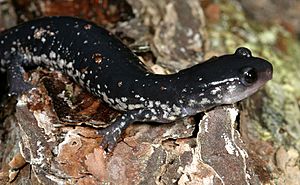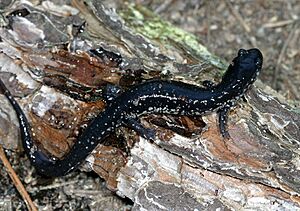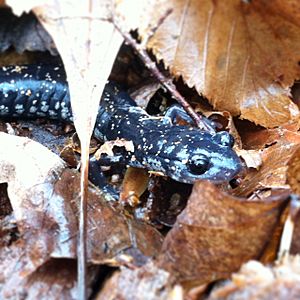Northern slimy salamander facts for kids
Quick facts for kids Northern slimy salamander |
|
|---|---|
 |
|
| Conservation status | |
| Scientific classification | |
| Synonyms | |
|
The northern slimy salamander (Plethodon glutinosus) is a cool salamander that lives on land. You can find it in many parts of the eastern and central United States. It's called "slimy" because of its skin, which helps keep it moist and can even protect it from predators!
Contents
Where They Live
These salamanders live in a large area across the eastern and central United States. You can find them from New York all the way west to Illinois. They also live south to Mississippi and east to Alabama. There are even a few groups living separately in southern New Hampshire and northwestern Connecticut.
Why They're Called "Slimy"
The northern slimy salamander gets its name from its skin. It feels very slimy! This sliminess helps keep the salamander's skin moist. It also makes them hard for predators to catch. Sometimes, people call them by other names. These include the viscid salamander, grey-spotted salamander, slippery salamander, or sticky salamander.
About Their Family Tree
The northern slimy salamander belongs to a group of salamanders called Plethodon. There are 57 different kinds of salamanders in this group. This specific salamander was one of the first in its group to be studied and named. Because they live in such a big area, some scientists think there might be more than one species. However, most scientists agree it's just one species for now.
What They Look Like
The northern slimy salamander is usually black. It has many shiny silver or gold spots on its back. Most of these salamanders are about 12 to 17 centimeters (5 to 7 inches) long. Some can grow even bigger, up to 20.6 centimeters (8.1 inches). It's hard to tell males and females apart. However, females are usually a little bit bigger. They have 15 to 17 grooves on their sides, which are called costal grooves.
How They Behave
All salamanders in the Plethodon group are very protective of their homes. They will even fight other salamanders for their territory. They like to live in damp soil or under fallen leaves. You can often find them under stones, rotting logs, or other things near water. Sometimes, they even use burrows dug by other animals. Their favorite foods are ants, beetles, sow bugs, and earthworms. But they will eat most kinds of insects they can find.
Life Cycle
Northern slimy salamanders breed in the spring. The male salamanders do a special dance to get the female's attention. Females lay a small group of eggs, usually 4 to 12. They place their eggs in a damp spot and guard them carefully. The mother salamander often doesn't eat much while she is protecting her eggs. The baby salamanders hatch from the eggs in about three months. Unlike many other salamanders, they don't have a water stage. Instead, they grow directly into their adult form on land. It takes them two to three years to become fully grown.




